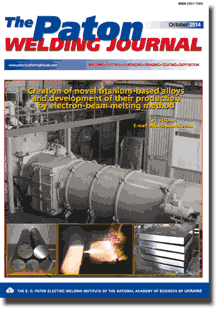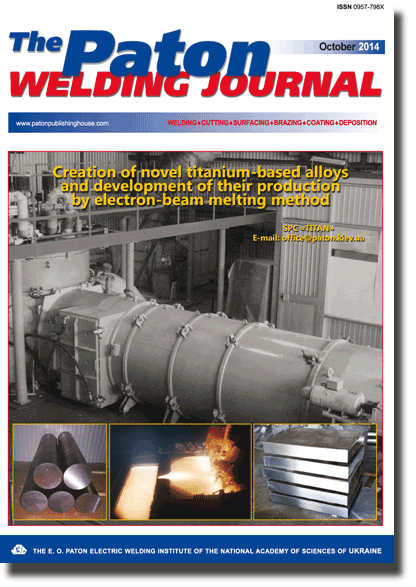Access for download PDF files for subscribers and for reviewers of scientometric bases.
Organization: Elsevier for content access(PDF files of journals released before 2024 are available for download from the website's archives))
Organization: Elsevier for content access(PDF files of journals released before 2024 are available for download from the website's archives))
| 2014 №10 (03) |
DOI of Article 10.15407/tpwj2014.10.04 |
2014 №10 (05) |

The Paton Welding Journal, 2014, #10, 22-25 pages
INFLUENCE OF HEATING RATE ON INFLAMMATION TEMPERATURE OF MUTLILAYER Ti/Al FOIL
D.N. KUZMENKO, A.I. USTINOV, S.G. KOSINTSEV and L.V. PETRUSHINETS
E.O. Paton Electric Welding Institute, NASU. 11 Bozhenko Str., 03680, Kiev, Ukraine. E-mail: office@paton.kiev.uaAbstract
Self-sustaining exothermal reaction of synthesis in multilayer foil consisting of intermetallic forming elements may proceed by means of self-propagation of high-temperature synthesis reaction front through foil (self-propagating high-temperature synthesis (SHS) or as a result of synthesis reaction running through the entire volume (autoinflammation (AI)). The latter is realized under the condition of foil heating up to a certain critical temperature, at which the synthesis reaction runs in the entire volume without external heat supply. In the work influence of foil heating rate on AI temperature was studied in the case of Ti/Al multilayer foil. It is shown that there exists a certain critical heating rate, below which foil AI is not observed, and at heating rates above the critical rate AI temperature decreases with increase of heating rate. Dependence of AI temperature on heating rate is nonmonotonic: at low heating rates AI temperature abruptly decreases, and at further increase of heating rate AI temperature remains practically unchanged. Such nonmonotonic dependence of foil AI temperature on heating rate is associated with running of the process of thermally activated solid phase reactions in it, which are accompanied by formation of intermetallic interlayers on the boundary between titanium and aluminium layers, preventing diffusion mixing of elements. With increase of heating rate, interlayer thickness decreases, promoting AI temperature lowering. 11 Ref., 4 Figures.
Keywords: multilayer foil, autoinflammation, electron beam vacuum deposition, thermal explosion, heat evolution
Received: 18.09.14
Published: 28.10.14
References
1. Merzhanov, A.G. (1983) Self-propagating high-temperature synthesis. Moscow: Khimiya.
2. Merzhanov, A.G. (2000) Solid flame combustion. Chernogolovka: ISMAN.
3. Ustinov, A.I., Falchenko, Yu.V., Ishchenko, A.Ya. et al. (2008) Diffusion welding of gamma-TiAl alloys through nanolayered foil of Ti/Al system. Intermetallics, 16, 1043-1045. https://doi.org/10.1016/j.intermet.2008.05.002
4. Wang, J., Besnoin, E., Duckham, A. et al. (2003) Room temperature soldering with nanostructured foils. Appl. Phys. Lett., 83, 3987-3989. https://doi.org/10.1063/1.1623943
5. Duckham, A., Spey, S.J., Wang, J. et al. (2004) Reactive nanostructured foil used as a heat source for joining titanium. J. Appl. Phys., 96, 2336-2342. https://doi.org/10.1063/1.1769097
6. Zaporozhets, T.V., Gusak, A.M., Ustinov, A.I. (2011) Conditions of propagation of the SHS reaction front in nanolayered foils in contact with heat-conducting material. The Paton Welding J., 8, 37-41.
7. Rogachev, A.S., Grigoryan, A.E., Illarionova, E.V. et al. (2004) Gas-free combustion of multilayer bimetallic Ti/Al nanofoils. Fizika Goren. i Vzryva, 40(2), 45-51.
8. (2003) Concept of SHS development as a field of scientific-technical progress, 7-12, 92-108. Chernogolovka: Territoriya.
9. Zaporozhets, T.V., Gusak, A.M., Korol, Ya.D. et al. (2013) Inverse problem for SHS in multilayer nanofoils: Prediction of process parameters for single-stage SHS reaction. Int. J. SHS, 22(4), 217-226. https://doi.org/10.3103/s1061386213040092
10. Ishchenko, A.Ya., Falchenko, Yu.V., Ustinov, A.I. et al. (2007) Diffusion welding of finely-dispersed AMg5/27 % Al2O3 composite with application of nanolayered Ni/Al foil. The Paton Welding J., 7, 2-5.
11. Trenkle, J.C., Koerner, L.J., Tate, M.W. et al. (2008) Phase transformations during rapid heating of Al/Ni multilayer foils. Appl. Phys. Lett., 93, 081903. https://doi.org/10.1063/1.2975830
Suggested Citation
D.N. Kuzmenko, A.I. Ustinov, S.G. Kosintsev And L.V. Petrushinets (2014) INFLUENCE OF HEATING RATE ON INFLAMMATION TEMPERATURE OF MUTLILAYER Ti/Al FOIL. The Paton Welding J., 10, 22-25.The cost of subscription/purchase order journals or individual articles
| Journal/Currency | Annual Set | 1 issue printed |
1 issue |
one article |
| TPWJ/USD | 384 $ | 32 $ | 26 $ | 13 $ |
| TPWJ/EUR | 348 € | 29 € | 24 € | 12 € |
| TPWJ/UAH | 7200 UAH | 600 UAH | 600 UAH | 280 UAH |
| AS/UAH | 1800 UAH | 300 UAH | 300 UAH | 150 UAH |
| AS/USD | 192 $ | 32 $ | 26 $ | 13 $ |
| AS/EUR | 180 € | 30 € | 25 € | 12 € |
| SEM/UAH | 1200 UAH | 300 UAH | 300 UAH | 150 UAH |
| SEM/USD | 128 $ | 32 $ | 26 $ | 13 $ |
| SEM/EUR | 120 € | 30 € | 25 € | 12 € |
| TDNK/UAH | 1200 UAH | 300 UAH | 300 UAH | 150 UAH |
| TDNK/USD | 128 $ | 32 $ | 26 $ | 13 $ |
| TDNK/EUR | 120 € | 30 € | 25 € | 15 € |
AS = «Automatic Welding» - 6 issues per year;
TPWJ = «PATON WELDING JOURNAL» - 12 issues per year;
SEM = «Electrometallurgy Today» - 4 issues per year;
TDNK = «Technical Diagnostics and Non-Destructive Testing» - 4 issues per year.


